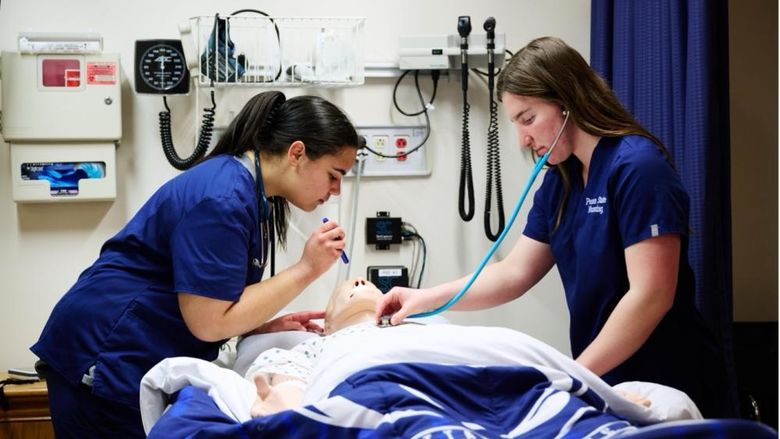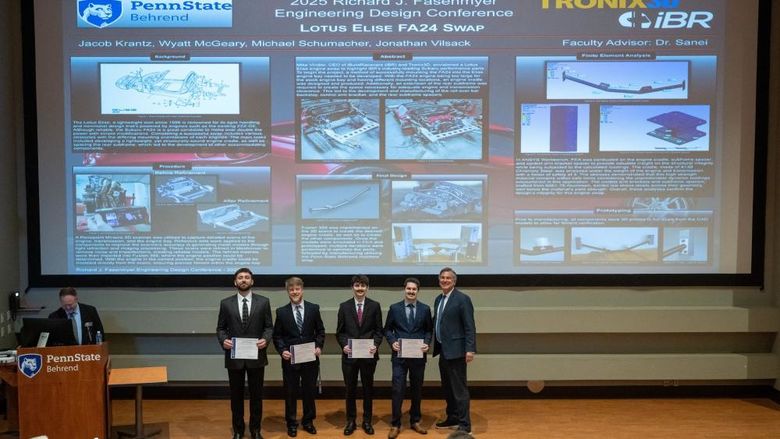Faisal Aqlan, an assistant professor of industrial engineering, at left, joins Phil Jones, a lecturer in engineering, and Joy Armbruster, an administrative support assistant, in the materials lab at Penn State Behrend's Advanced Manufacturing and Innovation Center. The team reconfigured the lab during a three-day event in late 2019.
ERIE, Pa. — In class, Assistant Professor of Industrial Engineering Faisal Aqlan often talks about the 5S framework, an efficiency model adopted from the Toyota Production System. Then he walks over to Penn State Behrend’s Advanced Manufacturing Lab, where floor tape and drawer labels — standard components of a 5S setup — make the space more efficient, and safer.
“A lot of this is common sense,” said Aqlan, “but it has to be structured, and it has to work for the people who use the space.”
5S is an acronym for five steps in the manufacturing process: sort, set in order, shine, standardize, and sustain. The Japanese engineers Eiji Toyoda and Taiichi Ohno developed the model beginning in 1948, after seeing inefficiencies in the assembly line at Ford and the inventory system at Piggy Wiggly.
Toyota’s approach includes a commitment to continuous improvement, which the Japanese call "Kaizen." That and other elements of the company’s production model — faster setup times, for example, and a “pull” method of ordering parts as they are needed — became the basis of the lean manufacturing movement.
Aqlan and a team from Penn State Behrend’s School of Engineering used the 5S framework to redesign the Advanced Manufacturing Lab during a three-day Kaizen event in late 2019. They studied workflows in the lab, which includes three rooms that are used by multiple faculty members and their students.
“Any time a group of people use a space for different purposes, for both teaching and research, that can be a challenge,” said Joy Armbruster, an administrative support assistant who worked with the team. “We were getting comments from faculty who thought the lab should be more organized.”
The team first looked for safety risks: trip hazards, pinch points and clear access to fire extinguishers.
“There was an automotive differential sitting on a table,” said Phil Jones, a lecturer in engineering. “We looked at that and thought, ‘Why is that even here?’ It’s round. It could have rolled off onto someone’s foot.”
Next, the team looked for ways to better organize the space. Researchers had been setting hand tools on the tops of two cabinets. The cabinets themselves were empty, however. Now, the tools are kept in drawers, which are clearly labeled.
“If you can’t find the tool you are looking for in 30 seconds,” Aqlan said, “you need to reorganize.”
The team removed equipment that was not being used. They labeled shelves, drawers and storage bins. They applied safety tape to portions of the floor, designating keep-clear spaces near fire extinguishers and other emergency equipment.
They created a 5S auditing checklist for the lab, which Armbruster will maintain. She’ll expand it as additional labs are reconfigured.
That monitoring is an essential final step in the process, Aqlan said.
“5S improvements are easy to implement but can be difficult to sustain,” he said. “You’re asking people to adjust their habits and adopt new routines. They need to see there’s a process, and that it works, before they’ll fully commit to it.”
Robb Frederick
Director of Strategic Communications, Penn State Behrend





